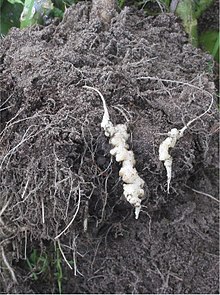Cercozoa
| Cercozoa | ||||||||||||
|---|---|---|---|---|---|---|---|---|---|---|---|---|

|
||||||||||||
| Systematics | ||||||||||||
|
||||||||||||
| Scientific name | ||||||||||||
| Cercozoa | ||||||||||||
|
Cavalier-Smith , 1998, emend. Adl. et al., 2005 |
The Cercozoa (" Cercus " from Greek kerkos "tail" and "zoa" from Greek "animal") are unicellular eukaryotes , that is, living beings with cell nuclei . According to the systematics of eukaryotes by Adl et al. 2005, they are counted among the Rhizaria .
features
This group includes several clades that have no salient morphological or behavioral characteristics. They have two cilia and / or are amoeboid , usually with filopodia . The cristae of the mitochondria are mostly tubules. Cysts are common. The kinetosome is connected to the cell nucleus via the cytoskeleton . They usually have microbodies and extrusomes . Three groups independently developed bowls.
In general, the feed cercozoa heterotroph , only the chlorarachniophyte are through the secondary Endosymbiosis with green algae for photosynthesis capable. Paulinella chromatophora has primary plastids of cyanobacterial origin, and Auranticordis quadriverberis may also have endosymbionts. There are a few small groups of endoparasites , but most of the species are wild zoo flagellates .
Occurrence
The Cercozoa live worldwide in fresh and salt water, as well as in soils. They include some of the most common protozoa.
Systematics

According to Adl et al. (2005), the Cercozoa include the following groups without a rank:
- Cercomonadida
- Silicofilosea
- Chlorarachniophyta
- Phytomyxea
- Phaeodarea
- Nucleohelea
- incertae sedis within the Cercozoa:
However, the same working group adapted the system significantly in 2012:
- Cercozoa Cavalier-Smith 1998, emend. Adl et al. 2005 (R)
- Cercomonadidae Kent 1880, emend. Mylnikov & Karpov 2004 [= Cercomonadida Poche 1913, emend. Vickerman 1983, emend. Mylnikov 1986, emend. Karpov et al. 2006; Cercobodonidae Hollande 1942]
- Pansomonadida Vickerman 2005
- Glissomonadida Howe & Cavalier-Smith 2009 [Heteromitidae Kent 1880, emend. Mylnikov 1990, emend. Mylnikov & Karpov 2004; Bodomorphidae Hollande 1952]
- Tremula Howe, et al. 2011 (M)
- Metromonadea Cavalier-Smith 2007, emend. Cavalier-Smith 2011
-
Granofilosea Cavalier-Smith & Bass 2009
-
Clathrulinidae Claus 1874 [Desmothoracida Hertwig & Lesser 1874]
- Incertae sedis Clathrulinidae: Servetia
-
Clathrulinidae Claus 1874 [Desmothoracida Hertwig & Lesser 1874]
-
Thecofilosea Cavalier-Smith 2003, emend. Cavalier-Smith 2011
-
Phaeodarea Haeckel 1879 [Tripylea Hertwig 1879]
- Phaeoconchia Haeckel 1879
- Phaeocystina Haeckel 1879
- Phaeogromia Haeckel 1879
- Phaeosphaeria Haeckel 1879
-
Cryomonadida Cavalier-Smith 1993 (R)
- Rhizaspididae Skuja 1948
- Protaspidae Cavalier-Smith 1993 (R)
- Ventricleftida Cavalier-Smith 2011
- Ebriacea Lemmermann 1901 [Ebriidae Poche 1913]
- Incertae sedis Thecofilosea: Chlamydophryidae de Saedeleer 1934, emend. Meisterfeld 2002
- Incertae sedis Chlamydophryidae de Saedeleer 1934: Capsellina , Chlamydophrys , Clypeolina , Diaphoropodon , Lecythium , Leptochlamydophrys , Penardeugenia
- Incertae sedis Thecofilosea: Botuliforma , Mataza , Pseudodifflugia
-
Phaeodarea Haeckel 1879 [Tripylea Hertwig 1879]
-
Imbricatea Cavalier-Smith 2011 [Cavalier-Smith 2003]
- Spongomonadida Hibberd 1983 [Spongomonadidae Karpov 1990]
- Nudifila Cavalier-Smith & Howe 2009 (M)
- Marimonadida Cavalier-Smith & Bass 2011
-
Silicofilosea Adl et al. 2005, emend. Adl et al. 2012
-
Thaumatomonadida Shirkina 1987 [Thaumatomastigidae Patterson & Zölfell 1991]
- Thaumatomonadidae Hollande 1952
- Peregriniidae Cavalier-Smith 2011
-
Euglyphida Copeland 1956, emend. Cavalier-Smith 1997
- Euglyphidae Wallich 1864, emend Lara et al. 2007
- Assulinidae Lara et al. 2007
- Trinematidae Hoogenraad & De Groot 1940, emend Adl et al. 2012
- Cyphoderiidae de Saedeleer 1934
- Paulinellidae de Saedeller 1934, emend. Adl et al. 2012
- Incertae sedis Euglyphida: Ampullataria , Deharvengia , Euglyphidion , Heteroglypha , Matsakision , Pareuglypha , Pileolus , Sphenoderia , Tracheleuglypha , Trachelocorythion .
-
Thaumatomonadida Shirkina 1987 [Thaumatomastigidae Patterson & Zölfell 1991]
- Incertae sedis Imbricatea: Clautriavia , Discomonas .
- Chlorarachniophyta Hibberd & Norris 1984
- Vampyrellida West 1901, emend. Hess et al. 2012
- Phytomyxea Engler & Prantl 1897
- Filoreta Bass & Cavalier-Smith 2009
- Gromia Dujardin 1835
-
Ascetosporea Sprague 1979, emend. Cavalier-Smith 2009
- Haplosporida Caullery & Mesnil 1899
- Paramyxida Chatton 1911
- Claustrosporidium Larsson 1987
- Paradiniidae Schiller 1935
- Incertae sedis Cercozoa: Psammonobiotidae Golemansky 1974, emend Meisterfeld 2002
- Incertae sedis Cercozoa: Volutellidae Sudzuki 1979
proof
- ↑ Chitchai Chantangsi, Heather J. Esson, Brian S. Leander: Morphology and molecular phylogeny of a marine interstitial tetraflagellate with putative endosymbionts: Auranticordis quadriverberis n. Gen. Et sp. (Cercozoa) . BMC Microbiology, Volume 8, 2008, Publication 123, (online)
- ^ David Bass, Thomas Cavalier-Smith: Phylum-specific environmental DNA analysis reveals remarkably high global biodiversity of Cercozoa (Protozoa) . International Journal of Systematic and Evolutionary Microbiology, Volume 54, 2004, pp. 2393-2404, doi : 10.1099 / ijs.0.63229-0
- ↑ Sina M. Adl et al .: The New Higher Level Classification of Eukaryotes with Emphasis on the Taxonomy of Protists. The Journal of Eukaryotic Microbiology, Vol. 52, 2005, pp. 399-451, doi : 10.1111 / j.1550-7408.2005.00053.x
- ↑ Adl, SM, Simpson, AGB, Lane, CE, Lukeš, J., Bass, D., Bowser, SS, Brown, MW, Burki, F., Dunthorn, M., Hampl, V., Heiss, A. , Hoppenrath, M., Lara, E., le Gall, L., Lynn, DH, McManus, H., Mitchell, EAD, Mozley-Stanridge, SE, Parfrey, LW, Pawlowski, J., Rueckert, S., Shadwick, L., Schoch, CL, Smirnov, A. and Spiegel, FW (2012): The Revised Classification of Eukaryotes. Journal of Eukaryotic Microbiology , 59: 429-514, 2012, PDF Online
